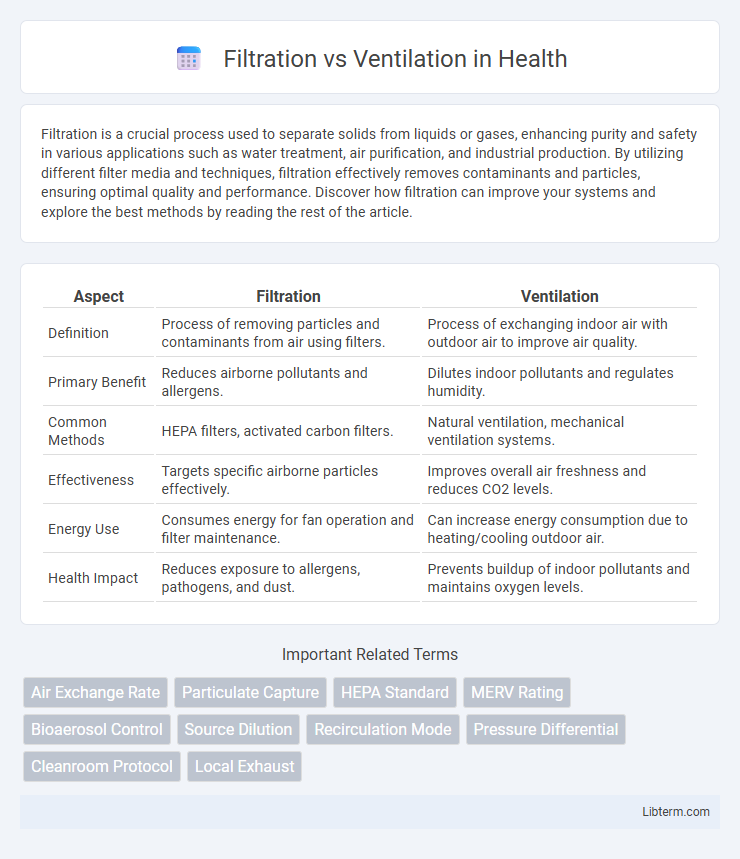Filtration is a crucial process used to separate solids from liquids or gases, enhancing purity and safety in various applications such as water treatment, air purification, and industrial production. By utilizing different filter media and techniques, filtration effectively removes contaminants and particles, ensuring optimal quality and performance. Discover how filtration can improve your systems and explore the best methods by reading the rest of the article.
Table of Comparison
| Aspect | Filtration | Ventilation |
|---|---|---|
| Definition | Process of removing particles and contaminants from air using filters. | Process of exchanging indoor air with outdoor air to improve air quality. |
| Primary Benefit | Reduces airborne pollutants and allergens. | Dilutes indoor pollutants and regulates humidity. |
| Common Methods | HEPA filters, activated carbon filters. | Natural ventilation, mechanical ventilation systems. |
| Effectiveness | Targets specific airborne particles effectively. | Improves overall air freshness and reduces CO2 levels. |
| Energy Use | Consumes energy for fan operation and filter maintenance. | Can increase energy consumption due to heating/cooling outdoor air. |
| Health Impact | Reduces exposure to allergens, pathogens, and dust. | Prevents buildup of indoor pollutants and maintains oxygen levels. |
Understanding Filtration and Ventilation
Filtration involves removing airborne particles, contaminants, and pollutants from indoor air using physical barriers like HEPA filters or activated carbon filters. Ventilation refers to the process of exchanging indoor air with outdoor air to reduce indoor pollutant levels and control humidity, often achieved through mechanical systems or natural airflow. Understanding the distinct roles of filtration and ventilation is crucial for improving indoor air quality, as filtration targets particle removal while ventilation manages air exchange and dilution of gases.
Core Differences Between Filtration and Ventilation
Filtration removes airborne pollutants by capturing particles through physical or chemical processes, whereas ventilation replaces contaminated indoor air with fresh outdoor air to dilute pollutants. Filtration systems are integral to HVAC units and focus on trapping dust, allergens, and microbes, while ventilation relies on airflow management to reduce indoor pollutant concentrations. The core difference lies in filtration's contaminant removal efficiency versus ventilation's emphasis on air exchange and dilution.
How Filtration Systems Work
Filtration systems work by capturing airborne particles such as dust, pollen, bacteria, and viruses through specialized filters composed of materials like HEPA, activated carbon, or electrostatically charged fibers. These filters trap contaminants as air passes through, significantly reducing indoor air pollutants and improving air quality. Unlike ventilation, which dilutes indoor air by introducing outside air, filtration recirculates and cleans existing indoor air effectively, especially in sealed environments.
Mechanisms of Ventilation Explained
Ventilation involves the movement of air in and out of the lungs, driven by pressure differences created by respiratory muscles such as the diaphragm and intercostal muscles. During inhalation, muscle contraction expands the thoracic cavity, decreasing intrapulmonary pressure and allowing air to flow in, while exhalation occurs as these muscles relax, increasing pressure and expelling air. Unlike filtration, which removes particles from air passing through a medium, ventilation ensures the continuous exchange of fresh air, essential for maintaining adequate oxygen and carbon dioxide levels in the bloodstream.
Advantages of Air Filtration
Air filtration effectively removes airborne particles such as dust, allergens, bacteria, and viruses, improving indoor air quality and reducing health risks associated with respiratory conditions. Unlike ventilation, which relies on introducing outdoor air that may contain pollutants, air filtration continuously cleans recirculated air, enhancing energy efficiency and maintaining controlled indoor environments. Advanced filtration systems like HEPA filters capture particles as small as 0.3 microns, providing superior protection in environments like hospitals, laboratories, and residential spaces prone to pollution.
Benefits of Proper Ventilation
Proper ventilation enhances indoor air quality by continuously replacing stale air with fresh outside air, reducing the concentration of pollutants such as carbon dioxide, volatile organic compounds (VOCs), and airborne pathogens. It helps regulate indoor humidity levels, preventing mold growth and maintaining structural integrity of buildings. Effective ventilation also supports occupant comfort and cognitive function by providing a steady supply of oxygen and removing excess heat and moisture.
Filtration vs Ventilation: Effectiveness Against Airborne Pollutants
Filtration targets airborne pollutants by capturing particles such as dust, pollen, and pathogens through mechanical or electronic filters, providing localized and consistent air cleaning. Ventilation dilutes indoor pollutants by introducing fresh outdoor air, effectively reducing concentration levels but relying on outdoor air quality and airflow rates. Filtration offers precise removal efficiency, often measured by MERV or HEPA ratings, whereas ventilation effectiveness depends on air exchange rates and environmental factors.
Energy Efficiency Considerations
Filtration systems require energy primarily to power fans that push air through filters, with higher efficiency filters increasing resistance and energy use, while ventilation often involves moving larger volumes of outdoor air, significantly raising heating or cooling loads. Energy recovery ventilators (ERVs) enhance ventilation efficiency by reclaiming energy from exhausted air, reducing overall HVAC consumption. Balancing filtration and ventilation based on building design and climate is essential to optimize indoor air quality without excessive energy costs.
Choosing the Right Solution for Indoor Air Quality
Selecting the appropriate indoor air quality solution depends on specific environmental needs and pollutant types. Filtration systems effectively remove particulate matter, allergens, and some airborne contaminants through HEPA or activated carbon filters, improving air purity in confined spaces. Ventilation enhances airflow and reduces indoor pollutant concentration by introducing fresh outdoor air, making it essential for controlling gases, odors, and maintaining oxygen levels in occupied environments.
Integrating Filtration and Ventilation for Optimal Results
Integrating filtration and ventilation enhances indoor air quality by combining particulate removal with fresh air exchange, reducing contaminants and controlling humidity levels effectively. High-efficiency particulate air (HEPA) filters paired with adequate ventilation rates ensure removal of allergens, dust, and airborne pathogens while maintaining balanced air circulation. Optimizing this integration involves selecting appropriate filter ratings, monitoring airflow, and tailoring ventilation based on space occupancy and pollutant sources for comprehensive air purification.
Filtration Infographic

 libterm.com
libterm.com